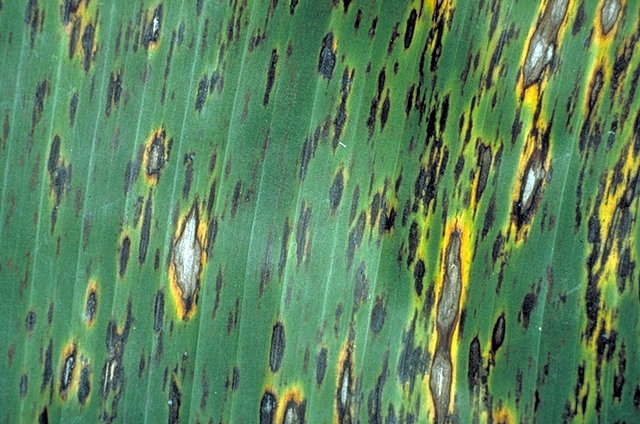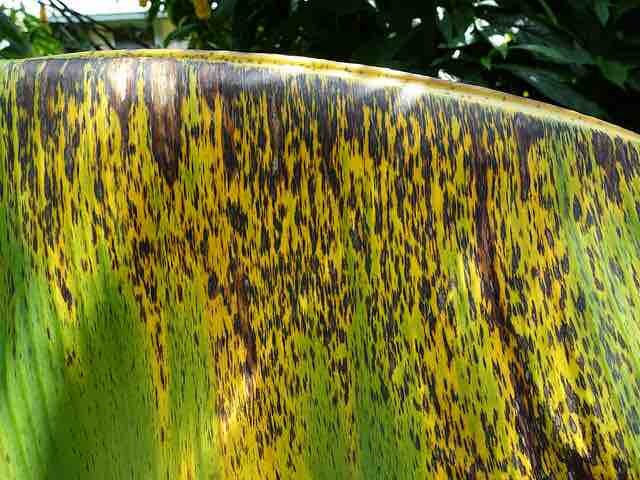
Black Sigatoka
Mycosphaerella fijiensis
Pathogen:
Fungus
Type:
Risk:
CRITICAL
Micosis/Hongos


WHO CAUSES IT?
Mycosphaerella fijiensis is a phytopathogenic ascomycete fungus that seriously affects banana trees. Its spread occurs through spores that are spread by wind and water. Under favorable temperature and humidity conditions, the fungus germinates on the surface of the leaves, penetrating through the stomata. As it progresses, it develops specialized structures for the colonization of leaf tissue, weakening the plant and reducing photosynthetic capacity. The infection remains latent for several days before symptoms become visible, favoring its spread. Over time, the fungus forms new sporulation structures in the foliar lesions, closing its cycle and restarting the infectious process. The persistence of the fungus in the residues of infected leaves contributes to reinfection, making its control difficult.
SYMPTOMS
Black Sigatoka seriously affects the development and yield of the banana tree by attacking its leaves, reducing photosynthetic capacity and weakening the plant. The first lesions appear as small dark brown streaks on the surface of the leaf, progressing progressively to form necrotic spots that spread and join, causing the premature death of the leaf tissue.
- Appearance of dark brown or blackish lines on the leaves.
- Irregular spots with a yellow halo that expand.
- Progressive necrosis of the leaf tissue.
- Premature wilting of affected leaves.
- Reduction in plant growth and vigor.
- Decrease in the size and quality of the fruits.
- Early defoliation in severe cases.

TEMPERATURE AND HUMIDITY
25°C - 30°C
90% - 100%
TRANSMISSION PATHS
Wind, rainwater, irrigation splashes, infected leaf debris, contaminated pruning tools, infected propagation material
Do you want to remove this pest? Choose how you want to treat it.
TREATMENTS
Chemical treatment
-
Authorized treatments in organic farming
-
Traitements biologiques
• BACILLUS SUBTILIS (SOUCHE QST 713) 1,34% [SC] P/V
Recommendations
- Use banana varieties that are resistant or tolerant to the disease.
- Implement periodic sanitary pruning to eliminate affected leaves and reduce the source of inoculum.
- Maintain adequate distance between plants to improve ventilation and reduce foliar humidity.
- Avoid sprinkler irrigation to minimize the spread of spores by splashing.
- Apply fungicides preventively and alternate active ingredients to avoid the appearance of resistance.
- Carry out constant monitoring to detect early symptoms and act immediately.
- Properly handle the remains of infected leaves, eliminating them or incorporating them into the soil to avoid re-inoculation.
- Promote the use of agroecological practices such as crop rotation and diversification to reduce pathogen pressure.
Sponsored link
Sponsored link
Sponsored link
Sponsored link
Sponsored link
Sponsored link
Effective against all types of fungi
TREATMENTS
Homemade treatments
There are no home treatments
Natural allies
Chemical treatments
There are no treatments for this disease. Treatments are directed at the insect vectors that transmit it. See insect treatments.
RECOMMENDATIONS
- Check the back of the leaves frequently, especially in dry weather.
- Spray water on the leaves to increase humidity and prevent them from settling.
- Keep plants healthy with good watering and adequate light.
- If you see cobwebs or damage, clean the leaves with a damp cloth or pressurized water.
- Use potassium soap or neem oil every few days until they disappear.
REPELLENT PLANTS
Rosemary, Dill, Coriander
RECOMMENDED PRODUCTS
Sponsored link
Sponsored link
Sponsored link
Sponsored link
Sponsored link
Sponsored link
Effective against all types of fungi
*The recommended treatments are still recommendations according to the databases of the authorities and at no time do they replace the guidelines established according to the legislation of each country
*The products shown are recommendations and are not our own products. As Amazon Associates, we earn revenue from purchases of recommended products.






















